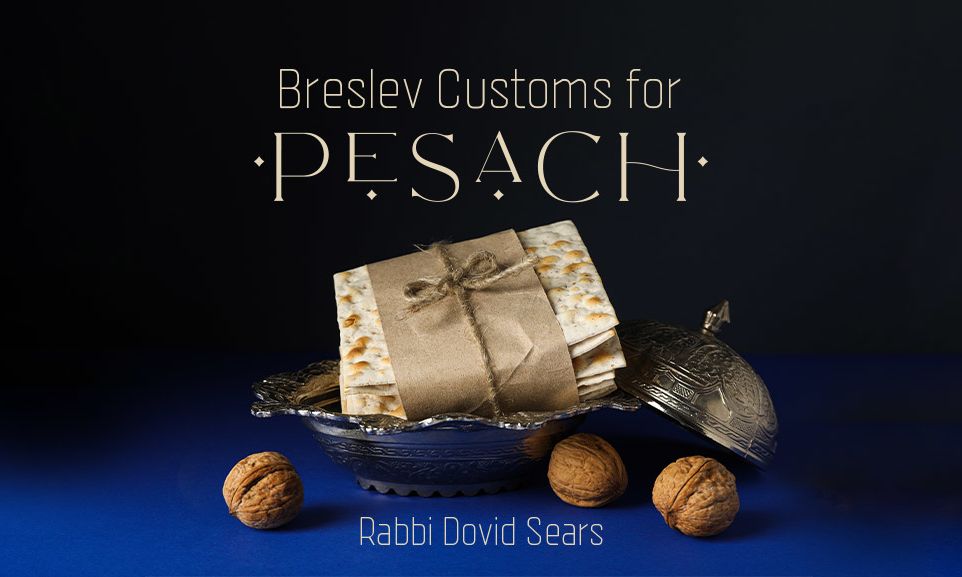
Breslev Customs for Pesach
Rebbe Nachman talks about the custom that once prevailed in Eastern Europe to turn over the tables after...

Table of Contents
Nissan
Rebbe Nachman taught that the days of Nissan are days of teshuvah, like the days of Tishrei (Likkutei Moharan I, 49).
* * *
Rebbe Nachman was born on Rosh Chodesh Nissan, which is the Mishnah designates as the “Rosh Hashanah shel malakhim,” the day on which the reign of a Jewish king officially begins. Today, many Breslover Chassidim travel to Uman to pray near Rebbe Nachman’s tziyun on Rosh Chodesh Nissan because it, too, is a “Rosh Hashanah,” and to some extent possesses the segulot of Rosh Hashanah.
* * *
Beginning on Rosh Chodesh Nissan, the minhag in the Ukraine was for each person to recite the Parshat Hanasi followed by the “yehi ratzon” after Shacharit, and not to read it from the Sefer Torah in public. This was also the Breslover minhag (as heard from Rabbi Michel Dorfman z”l).
However, in recent years it became the minhag in the Tzefat Breslov community to read the Parshat Hanasi from the Sefer Torah. This change was made to prevent people from forgetting to read Parshat Hanasi.
* * *
Rabbi Elazar Kenig and a group of his students from Tzefat usually travel to Uman immediately after Pesach to spend the last days of Nissan at Rebbe Nachman’s tziyun. The group spends one day visiting the graves of the Tzaddikim in Berditchev, Medzhibuzh, and Breslov. While in Uman, Rabbi Elazar teaches Sippurei Ma’asiyot and Likkutei Moharan every day, and the group recites Tikkun ha-Klalli together.
* * *
Rabbi Gedalia Kenig Kenig and his talmidim used to travel to Tzefat to pray there on Erev Rosh Chodesh Iyar. When asked about this, Rabbi Gedalia Kenig Kenig explained that this was the date that Nachal Novea Mekor Chochma purchased the first property in Tzefat (as heard from Rabbi Dovid Shapiro).
Shabbat HaGadol
After Minchah it is customary to recite the Haggadah, beginning with “‘Avadim hayinu” until “le-khaper ‘al kol ‘avonoteinu.” One does so even if Shabbat haGadol comes out on Erev Pesach (RaMA, Orach Chaim 430:1; Mishnah Berurah, ad loc.).
* * *
Rebbe Nachman talks about the custom that once prevailed in Eastern Europe to turn over the tables after Shabbat HaGadol. The tables were commonly made so that the top rested on the legs. Therefore, by turning over the top, one was provided with a new, chometz-free surface (see Sichot ha-Ran 88).
Erev Pesach
The Rav of Tcherin writes that there is no special custom in Breslov to bake Erev Pesach matzot, which entails many halachic risks if conditions are not optimal. “However,” he adds, “if one can do so properly and without great difficulty, ‘mah tov u-mah na’im,’ ‘how good and how pleasant'” (Si’ach Sarfei Kodesh IV, 257). Rabbi Elazar Kenig has a copy of an unpublished letter from Reb Nosson asking for wheat in order to bake matzot on Erev Pesach. This was a custom of the Baal Shem Tov still observed in many circles (see Shivchei Baal Shem Tov [Avraham Rubenstein, ed.] 199; Siddur ARI Rav Shabbsai, Seder Erev Pesach, et al.).
* * *
Rabbi Gedalia Kenig did not bake Erev Pesach matzot. He was particular not to use them, due to the halachic problems surrounding them (as heard from Rabbi Yitzchak Kenig, Rabbi Chaim Mann, and Rabbi Moshe Grinberger).
* * *
Sometime after chatzot, Rabbi Gedalia Kenig would recite the letter of Rabbi Shimshon Ostropolier, printed in many editions of the Haggadah. He strongly encouraged others to do so, as well (as heard from Rabbi Moshe Grinberger).
* * *
After Minchah, Rabbi Gedalia Kenig would read recite the account of the Korban Pesach. This is the common minhag. However, it is not clear which nusach he followed (as heard from Rabbi Ephraim Kenig).
Pesach
On the first night of Pesach (and also on the second night in chutz la’aretz) after Ma’ariv, it is a universal Chassidic custom to recite the full Hallel be-tzibbur. Reb Nosson mentions this in Likutei Halakhot (Shulchan Arukh, Orach Chaim 487:3, with RaMA; Rabbi Chaim Vital, Sha’ar ha-Kavannot, Drushei Pesach, Drush 3, 81b; also see Likutei Halakhos, Even ha-‘ezer, Pru u-Revu 3:29).
* * *
One is required to use shemurah matzah (i.e. made from wheat that was guarded from the time of harvesting) for the sedorim. If possible, one should also use them for the entire Pesach. In Rebbe Nachman’s day, however, this presented a great difficulty for many Chassidim. Thus, once a Chassid came to Rebbe Nachman and asked him if it was mandatory to supply his entire family with shemurah matzot (in the Ukraine and neighboring regions pronounced “shemirah”). “Shemirah matzot?” Rebbe Nachman replied. “Something else needs shemirah…” – referring to shemirat ha-brit (Oral tradition. For a variant mesorah, cf. Si’ach Sarfei Kodesh II, 37).
* * *
Rebbe Nachman once picked up a matzah pshutah (i.e. not made from wheat that was guarded from the time of harvesting), and said, “Az meh halt matzah in der handt, halt men G-tt in der handt,” “When one holds matzah, one grasps God!” (Si’ach Sarfei Kodesh II, 51. Obviously this does not mean that the matzah is “God” in the literal sense. As a historical note, all matzot were hand-made in Rebbe Nachman’s day, both shemurah matzot and non-shemurah matzot. Machine matzot were first introduced during Reb Nosson’s lifetime, several years after Rebbe Nachman’s death.)
* * *
Nevertheless, Rabbi Gedalia Kenig used only hand-made shemurah matzot, and encouraged his students to do likewise. This is the common practice in Breslover communities today (as heard from Rabbi Chaim Mann).
* * *
During Rabbi Gedalia Kenig’s younger years, machine matzot were both less expensive and easier to digest than hand matzot. Although he refrained from using them, he did not consider them to be of questionable kashrut (as heard from Rabbi Chaim Mann. As a historical note, Yerushalayim was a predominantly “Litvishe” community, and machine matzot were widely used. In addition, many Yerushalayimer rabbonim came from the school of the Chasam Sofer, which viewed machine matzot as preferable to hand-made matzot.)
* * *
In Rabbi Gedalia Kenig’s home, the children ate machine matzot until they reached the age of bar mitzvah and bat mitzvah. They used matzot pshutos, not shemurah matzot (Rabbi Ephraim Kenig).
* * *
Nevertheless, these machine matzot were served separately. Rabbi Gedalia Kenig did not allow them on his table. It seems likely that he gave his children non-shemurah machine matzot due to poverty, and because they were easier for children to digest. Food was not plentiful, and this way he could give them enough to eat.
* * *
With the persecutions that followed the Russian Revolution, and then those of Stalin, Breslover Chassidim began to flee the Ukraine, and a number came to Yerushalayim. There, machine matzot were widely used, which had the hashgochah of the BaDaTZ of the Eidah ha-Chareidis. Thus, Rabbi Elyah Chaim Rosen, Rosh Yeshivah of Jerusalem’s Breslov Yeshivah, used machine matzot, as did other prominent Breslovers such as Rabbi Yitzchok Gelbach, Rabbi Moshe Rosenthal, and possibly Rabbi Meir Anshin (as heard from Rabbi Yosef Cheshin).
* * *
Rabbi Ephraim Kenig observed that if these prominent Chassidim had felt that the use of machine matzot was foreign to the ru’ach of Breslov, they never would have done so. Therefore, this cannot be an issue that divides the Chassidim from non-Chassidim, but is a practical matter that depends upon each person’s circumstances.
* * *
Rabbi Levi Yitzchak Bender once remarked: “I knew people who ate machine matzot who are in Gan Eden today; and I knew people who ate hand matzot who are in Gehinom today. Ober mir fieren zach az meh est handt matzot,” “However, our custom is to eat hand matzot” (as heard from Rabbi Shlomo Chaim Vitriol).
* * *
There was a regional custom in the Ukraine to use razaveh matzot, whole-wheat matzot. For example, the Rabbi Moshe Bick of Borough Park, whose ancestors were the rabbonim of Medzhibuzh, was particular to use razaveh matzot. However, it does not seem that there was any hakpadah about this in Breslov. (See ‘Erkhei Yehoshua [Mannistritch], Perach Shoshanim 107, that this was considered a hiddur; similarly minhagei Chernobyl-Skver. The Hornestiepler Rebbe of Flatbush, Rav Mordekhai Twersky, similarly follows this minhag.)
* * *
Like his saintly great-grandfather, the Baal Shem Tov, Rebbe Nachman did not eat gebrokhts (matzoh or matzoh products cooked or dipped in water). However, in the Breslov community this chumrah is not taken to extremes. This is due to Rebbi Nachman’s remarks in Sichot ha-Ran (English: “Rebbe Nachman’s Wisdom,” Breslov Research Institute), section 235, about not allowing chumrot yeteirot (excessive stringencies) to spoil one’s Yom Tov. Therefore, although most Breslovers refrain from gebrokhts, those who have a previous custom to eat gebrokhts are not obligated to change. Rabbi Gedalia Kenig Kenig and other prominent Breslover teachers were lenient with their families about eating matzoh with butter or cheese, as long as they do not contain water. Most Breslovers are not concerned if a few crumbs fall on the table, as long as they do not fall into liquid, or onto one’s plates, etc.
* * *
In Rabbi Gedalia Kenig’s home, during the Sedorim and all the Pesach meals, matzot were served on the table, and were not eaten in a matzah bag, etc. (Some communities do so to protect the matzot from accidentally coming in contact with liquids; however, Rabbi Gedaliah was not machmir about this)(as heard from Rabbi Ephraim Kenig).
* * *
Rabbi Gedalia Kenig said that if necessary, one may give gebrokhts to small children, but they should have separate dishes for this purpose (as heard from Rabbi Dovid Shapiro).
* * *
He personally allowed his children to eat gebrokhts until they reached the age of bar mitzvah or bat mitzvah, although prepared and served in separate keilim (as heard from Rabbi Ephraim Kenig).
* * *
In Rabbi Gedalia Kenig home, they did not peel fruits and vegetables for Pesach, but merely washed them thoroughly (as heard from Rabbi Ephraim Kenig. However, today’s produce is often sprayed with various substances, possibly containing kitniyot [legumes]. One should consult a qualified Rov about how to conduct oneself with these foods).
* * *
As a rule, Rabbi Gedalia Kenig rarely used commercially prepared food products throughout the year, and all the more so on Pesach. However, he had no chumrot about fruits and vegetables on Pesach (For example, a number of people refrain from garlic on Pesach). Likewise, he had no chumrot regarding meat, poultry, or fish (as heard from Rabbi Ephraim Kenig).
* * *
Rabbi Gedalia Kenig used pre-ground pepper and other spices with a Pesach hechsher (as heard from Rabbi Chaim Mann).
* * *
Rabbi Gedalia Kenig was meikel [lenient] concerning eating at the homes of other family members, mechutonim, etc., who kept a similar level of kashrut and did not eat gebrokhts on Pesach. When he and his family visited relatives on Chol ha-Mo’ed, they would eat in their homes (as heard from Rabbi Ephraim Kenig).
* * *
Like most Chassidim, Breslover married men wear a kittel or white caftan at the sedorim. In Tzefat, the minhag is to wear a white caftan or kittel to shul on Pesach night, and subsequently at the Seder meal, but not on Pesach by day (as heard from Rabbi Yitzchak Kenig).
* * *
Like most communities today, Breslover Chassidim arrange the ka’arah (Seder plate) according to the custom of the ARI zal. That is, the three matzot (Chokhmah-Binah-Da’at) are placed under the six simanim, with the zero’a / bone (Chesed) to the upper right, beitzah / egg (Gevurah) to the upper left, morror / bitter herbs (Tiferet) in the middle, charoset / chopped fruit and nuts with grape juice or wine (Netzach) to the lower right, karpas / celery, parsley, or another vegetable that grows from the ground (Hod) to the lower left, and chazeret / second portion of bitter herbs (Yesod) between them, under the morror. The ka’arah itself corresponds to Malkhus. (See Be’er Heitiv, Orach Chaim 473, s.k. 8; Mishnas Chassidim, Seder Leyl Pesach 2; Siddur ARI Rav Shabbsai, et al. Arukh ha-Shulchan, Orach Chaim 473:11, states that this is the prevailing Ashkenazic custom today. However, the RaSHaSH and other Sefardic mekuballim have a different mesorah, according to which the matzot are not placed underneath the six simanim, but above them on the ka’arah. This is possible because traditionally the Sefardic matzot are smaller and are made somewhat like pita breads. An interesting exchange on this subject between Rav Asher Zelig Margolios and the Minchat Elazar appears as an appendix to Kocho de-RaSHBY, pp. 18-23.)
* * *
Rabbi Avraham Sternhartz also arranged the ka’arah in this manner (as heard from Rabbi Michel Dorfman).
* * *
The matzot may be placed in a cloth bag with three sections; or between napkins; or in a special metal unit with three metal racks and a ka’arah on top. Rabbi Gedalia Kenig did not own a special holder, but used to rest a plate containing the simanim in small vessels directly on top of the covered matzot. Rabbi Elazar explained that this was another example of his father’s extraordinary histapkut – contentment with his modest material circumstances and avoidance of luxuries, even when it came to the performance of certain mitzvot.
* * *
Rabbi Gedalia Kenig’s minhag was to use romaine lettuce for morror, and took the “kepeleh,” the part from which the leaves grow, for chazeret on the Seder plate. Once he tried to use chrein (horseradish), but found it damaging to his health (as heard from Rabbi Ephraim Kenig. Shulchan Arukh, Orach Chaim 473:5 states that romaine lettuce is the preferred type of morror. This is based on Pesachim 39a. However, cleaning these leaves to remove insects may be a difficult and time-consuming task. Therefore, some just use lettuce stalks. Special insect-free lettuce with rabbinic supervision is also available today.)
* * *
Rabbi Avraham Sternhartz used chrein for morror (as heard from Rabbi Michel Dorfman).
* * *
Since insect-free romaine lettuce was then unavailable, Rabbi Gedalia Kenig advised his talmidim to put the lettuce in the coldest part of the refrigerator overnight. This would cause the insects to loosen their grip, so that cleaning would be easier the next day (as heard from Rabbi Dovid Shapiro).
* * *
For karpas, Rabbi Gedalia Kenig at first used potatoes, and then changed to a raw celery root (not the stalks or leaves), in keeping with the view of the ARI zal. However, he also continued to serve cooked potatoes, which some people prefer. Manny Sefardic kabbalists also use celery root for karpas (as heard from Rabbi Elazar Kenig and Rabbi Ephraim Kenig. This is supported by Kitzur Shulchan Arukh 118:2, Teshuvot Chasam Sofer, Orach Chaim, no. 132. See Rabbi Chaim Vital, Sha’ar ha-Kavannot, ‘Inyan Pesach, Drush 6, that the ARI was particular to use karpas and not any other vegetable. Sefardic authorities understand this to mean the celery knob. Darkei Chaim ve-Shalom 589 states that the Minchat Elazar used a small amount of petrizeil, parsley leaves, which he held to be the karpas mentioned in the Gemara and kitvei ARI zal. Some use the parsley root. The Hornestiepler Rebbe of Flatbush, Rabbi Mordekhai Twersky, told me that his family minhag is to use radishes. Bobover Chassidim use cucumbers. However, many Eastern European Jews used potatoes.)
* * *
In any case, Breslover Chassidim do not use raw onions for karpas, in keeping with the Rebbe’s family mesorah that the Baal Shem Tov said not to eat raw onions (see Sichot Haran 265).
* * *
However, Rabbi Gedalia Kenig did not consider raw scallions to be the same as onions. When he spent Pesach in Brooklyn, at the home of Rabbi Moshe Grinberger, he considered using them for karpas (as heard from Rabbi Moshe Grinberger).
* * *
Rabbi Gedalia Kenig would eat the karpas without reclining (as heard from Rabbi Ephraim Kenig. This follows the view of Shevilei Leket, 64; Matteh Moshe 626; Birkhei Yosef 474:14; Siddur ARI Rav Shabsai; Darkei Chaim ve-Shalom [Munkatch] 590; Minhagei Chabad; et al. However, those who recline follow the shittah of Abudarham.)
* * *
For zero’a, Rabbi Gedalia Kenig used a roasted chicken wing (as heard from Rabbi Yitzchak Kenig).
* * *
For beitzah, Rabbi Gedalia Kenig used a hard-boiled egg, but he did not roast it (as heard from Rabbi Ephraim Kenig).
* * *
Manny Breslover Chassidim use the Haggadah Ohr Zarei’ach compiled by Rabbi Moshe Yehoshua Beziliansky, better known as Rabbi Alter Tepliker. This work is a digest of Breslover teachings related to the text of the Haggadah. However, there is nothing special about the nusach of this Haggadah.
* * *
Rabbi Gedalia Kenig said “Ha lachma ‘anya,” with a kametz under the heh, as in most versions of the Haggadah, not “Heh lachma ‘anya,” with a tzeyre under the heh — although the latter is the nusach of the ARI zal. (The common nusach of “hah” with a kametz is mentioned in Shulchan Arukh, Orach Chaim 473:6. For the nusach of the ARI zal, see Rabbi Chaim Vital, Pri Eitz Chaim, Sha’ar Chag ha- Matzot, 7; Mishnat Chassidim, Masechtat Seder Leyl Pesach, 5:2, et al. This is based on several pesukim: Bereishit 47:23, Yechezkel 16:43, and Daniel 2:43.)
* * *
Rabbi Gedalia Kenig followed the more common order of “Mah nishtanah” (Matzah, Maror, Matbilin, Mesubin), not that of the Yerushalmi (Matbilin, Matzah, Maror, Mesubin) —although the ARI zal preferred the latter.
(The common nusach is that of the Talmud Bavli, and is cited in the Machzor Vitry. It also appears in all of the Slavita siddurim. The ARI zal follows nusach of the Yerushalmi, as redacted by the RIF, RaMBaM, Rosh, and Baal ha-Roke’ach; see Rabbi Chaim Vital, Pri Eitz Chaim, Sha’ar Chag ha-Matzot 7. Chassidic sources that follow the minhag ARI include Siddur Baal ha-Tanya; Darkei Chaim ve-Shalom [Munkatch] 599; ‘Erkhei Yehoshua [Mannistritch], Perach Shoshanim 121; Siddur Tzelosa de-Shlomo [Bobov]; et al. The ARI explains that the Four Questions parallel the Four Worlds, in ascending order.)
* * *
After the “Mah nishtanahs,” Rabbi Gedalia Kenig used to exclaim, “Oo-ah! Azoyne shtarkeh kashas,” “Such strong questions!” Then he would say “Der teretz is,” “The answer is…” and recite “Avodim hoyinu”(as heard from Rabbi Ephraim Kenig).
* * *
Sometimes he would add: “Me darf es noch fahrenferen. tzorekh biur,” “We need to give more of an answer. This needs explanation” (as heard from Rabbi Ephraim Kenig).
* * *
Rebbe Nachman stated that reciting the Haggadah in a loud voice (be-kol ram) is a form of tikkun ha-brit, rectification of the Covenant (Likkutei Moharan I, 20:10).
* * *
Rabbi Gedalia Kenig recited the Haggadah like a “flamm fier,” with intense passion. He conducted the Seder with great sincerity and yirat Shemayim, creating a rarified atmosphere that affected everyone present. He did not allow the emotional climate to degenerate, notwithstanding all the children and the lateness of the hour, but maintained this exalted mood from beginning to end(as heard from Rabbi Ephraim Kenig).
* * *
Rabbi Gedalia Kenig usually spoke briefly after “‘Avodim hoyinu,” and sometimes once more during “Maggid.” However, as a rule he and his sons and guests did not comment on the Haggadah or engage in lengthy discussion. Rather they remained focused on the Haggadah and the mitzvot, and tried to finish eating the Afikoman before chatzot (as heard from Rabbi Ephraim Kenig).
* * *
Rabbi Ephraim Kenig once remarked that the way his father recited the Haggadah, intensely probing the meaning of its words, was “a peirush af der gantzeh Haggadah,” “a commentary on the entire Haggadah.”
* * *
Rabbi Gedalia Kenig would spill a drop of wine while reciting each of the Ten Plagues, and did not remove wine with his finger (Rabbi Chaim Vital, Pri Eitz Chaim, Sha’ar Chag ha-Matzot 7, with glosses of Rabbi Yaakov Tzemach, hagahah 1; cf. Shulchan Arukh ha-Rav 473:51, s.v. “ve-yesh nohagin”; Kaf ha-Chaim, ad loc. 166. The custom of using one’s finger is also mentioned by these sources, as well as by the RaMA, Orach Chaim 473:74).
* * *
Breslover Chassidim in Uman used a combination of apples, pears, nuts, and wine for charoset. This is the common Russian-Ukrainian custom (although some omit pears). However, Rabbi Gedalia Kenig used a combination of fruits and spices. (See Sha’ar ha-Kavannot, Drushei Pesach, Drush 6, end, where Rabbi Shmuel Vital mentions that this is the minhag Ashkenaz. A mnemonic device for this is the word “even”: eppel-barrennussen / apples, pears, nuts. Rabbi Meir Poppers notes that this does not reflect the kabbalistic custom. However, the ARI zal used seven fruits and three spices: grapes, figs, pomegranates, dates, walnuts, apples, and pears, spiced with spikenard, ginger, and cinnamon. Rabbi Shmuel Vital adds that he saw his father Rabbi Chaim pound these ingredients and knead them with wine specifically, and not with vinegar. Ben Ish Chai, Halakhos II, Mishpatim 19, and Akim Es Yitzchak, 25, state that in Baghdad the minhag was to use date honey with nuts. In many parts of Europe, only apples, nuts, and wine were used; e.g. ‘Erkhei Yehoshua [Mannistritch], Perach Shoshanim 121. Similarly, minhagei Skver-Chernobyl, Chabad, etc.)
* * *
Rabbi Gedalia Kenig used to save a pomegranate from the Sukkah decorations in the refrigerator until Pesach, in order to use it in the charoset (as heard from Rabbi Ephraim Kenig).
* * *
In addition, Rabbi Gedalia Kenig used a combination of almonds, walnuts, apples, pears (if available), dates, cinnamon, and ginger. He did not use figs(as heard from Rabbi Elazar Kenig).
* * *
Rabbi Gedalia Kenig would dip the morror in charoset for both morror and korekh, and shake it off. He did not eat charoset together with the matzah and morror for korekh (as heard from Rabbi Ephraim Kenig. According to ‘Erkhei Yehoshua’, Perach Shoshanim 131, the Mannistritcher minhag was to include charoset in the korekh / sandwich. Sefer Minhagim-Chabad states that one dips the romaine lettuce in charoset and then shakes it off, as prior to eating the marror).
* * *
When Rabbi Avraham Sternhartz ate the morror, he would exclaim again and again, “Ot azoy is gevezen bitter di Yidden,” “Just like this, it was bitter for the Jews!” Rabbi Gedalia Kenig used to repeat what Rabbi Avraham Sternhartz said when he ate the marror, as well (as heard from Rabbi Ephraim Kenig).
* * *
During the meal, Rabbi Gedalia Kenig would use a bed in order to recline while eating. However, he would sit in the usual manner while eating the soup, or if it became difficult for him at some point (as heard from Rabbi Ephraim Kenig. This reflects the view of the Rama, Shulchan Arukh, Orach Chaim 472:7, end; also cf. Mishnah Berurah, ad loc., that this is only le-chatchilah. Some say that this is entirely not applicable today; see Piskei Teshuvos, ad loc.).
* * *
In Rabbi Gedalia Kenig’s home, they would eat the egg after the fish, not immediately at the beginning of the meal. He used the egg on his ka’arah (unlike those who leave all the minim on the ka’arah for the entire Seder) (as heard from Rabbi Ephraim Kenig).
* * *
Rabbi Gedalia Kenig would slice the egg into sections, dip them in salt water, and give them to everyone with a spoon. If he needed more slices, he would use a second egg, in addition to the one from the ka’arah. Before eating the egg, he would announce, “Zekher le-chagigah” (as heard from Rabbi Ephraim Kenig).
* * *
Regarding eating the Afikoman before chatzot, Breslover Chassidim follow the Rebbe’s view that chatzot is six sixty-minute hours after three stars appear (Si’ach Sarfei Kodesh IV, 141; concerning Rebbe Nachman’s shittah concerning the time of chatzot, see above, Part I).
* * *
Rabbi Dovid Shapiro once asked Rabbi Gedalia Kenig about this, and he hesitated. However, eventually he said that we could rely on Rebbe Nachman’s chatzot. Rabbi Dovid speculated that Rabbi Gedalia Kenig’s hesitation seemed to reflect the fact that some Poskim who follow this shittah for chatzot say that it does not apply to korbonot, and the Afikoman commemorates the Korban Pesach (See Rabbi Simcha Ben Zion Rabinovitch, Piskei Teshuvot, vol. V, “Leyl Pesach,” in his discussion of Orach Chaim 477, that one should be particular to eat the Afikoman before chatzot. He mentions that the Chasam Sofer, Rabbi Moshe Leib Sassover, Rabbi Chaim Brisker, NeTZiV of Volozhin, and others were not particular to do so. Teshuvot Minchat Yitzchak, vol. IX, no. 48, points out that this is a matter of zehirut le-chatchilah; however, if one fails to do so, one is nevertheless yotzei with the matzah eaten during the meal; see Mishnah Berurah, Orach Chaim 477:2, s.k. 12. As for not eating after the Afikoman, the Minchat Yitzchak states that this may be rectified by eating matzah at the end of the se’udah, even after chatzot. Another approach is that of the Avnei Nezer, who opines that one may eat a shiur of matzah be-hasebah before chatzot and then after chatzot at the end of the se’udah, with the tenai that if the halakhah follows the view of Rabbi Elazar ben Azariah [Pesachim 120b], the first shiur should be considered the Afikoman, and if the halakhah is according to Rabbi Akiva, the second shiur should be considered the Afikoman. Rabbi Velvel Brisker lauded this ‘eitzah, adding that even without an explicit tenai, it works; see Haggadah Beis Levi. However, the Minchat Yitzchak contends that it is preferable not to make such a stipulation, see there at length.)
* * *
Nevertheless, Rabbi Ephraim Kenig remembers that once or twice his father urged his children to return his Afikoman to him because it was getting close to chatzot – meaning the more common shittah of chatzot. The implications of this are unclear, due to the circumstances and his other statements about chatzot.
* * *
In Rabbi Gedalia Kenig’s home, the children would “steal” the Afikoman, and barter to return it to the owner. This is the common Ashkenazic minhag (as heard from Rabbi Ephraim Kenig).
* * *
Rabbi Gedalia Kenig would place the Kos shel Eliyahu on the table at the beginning of the Seder and fill it after bentching. He used a slightly larger kos than the rest, made of glass, not silver (as heard from Rabbi Yitzchak Kenig).
* * *
For “Shfokh chamotkha,” Rabbi Gedalia Kenig would send someone to the open the front door. Upon that person’s return, he would ask, “Did you open the door?” When the one who did so replied in the affirmative, he would immediately cry out “Borukh haboh!” to welcome Eliyahu haNavi (Elijah the Prophet)(as heard from Rabbi Ephraim Kenig).
* * *
Rabbi Gedalia Kenig, his guests, and any children who were still awake would sing all of the zemirot after the Haggadah.
* * *
Rabbi Gedalia Kenig was accustomed to remain awake until dawn after the Seder, reciting Shir ha-Shirim. Then he would go to the mikveh and daven at sunrise.
First Night of Sefirat ha-‘Omer: On the second night of Pesach, we begin to count sefirah. For those living in chutz la-aretz, there are conflicting minhagim about this among the kabbalists, and among Breslover Chassidim, too. Some Breslover Chassidim in Uman counted sefirah in the synagogue after Ma’ariv, according to the view of the Shulchan Arukh. However, according to Rabbi Levi Yitzchak Bender, most counted sefirah after the Seder. This seems to have been a regional minhag that is still followed by some Breslover Chassidim in chutz la-aretz today. Rabbi Levi Yitzchak also mentioned that the legendary ‘oved, Rabbi Getcheh of Uman, was accustomed to count Sefirat HaOmer in shul with a minyan of bochurim, who made the Seder meal with him in the Beit Medrash. (Si’ach Sarfei Kodesh IV, 262. In support of this custom, see Rabbi Immanuel Chai Ricci, Mishnas Chassidim, Masechtat ha-‘Omer 1:1; Rabbi Menachem Azariah of Pano, Mayan Ganim, Seder shel Pesach, 35b; Siddur Tefilah Yesharah-Berditchev. The Chassidim of Karlin-Stolin count in shul be-tzibbur after the Seder. Others who count after the Seder include the communities of Chernobyl-Skver, Bobov, Klausenberg, Boyan-Rizhin, etc. However, the RaSHaSH held that one should count after Ma’ariv, not after the Seder; similarly, minhagei
Chabad, et al.)
Acharon shel Pesach (the last day of Pesach): In chutz la’aretz, gebrokhts are prepared and eaten on Acharon Shel Pesach. However, this is not the custom in Eretz Yisrael (where Acharon shel Pesach is still a yom tov de-oreisa).
* * *
The last meal of Acharon Shel Pesach is called the “Baal Shem Tov Se’udah,” during which it is customary for a member of the group to retell the story of the Baal Shem Tov’s attempted journey to the Holy Land. There is a special Breslover mesorah concerning the details of this story, preserved by oral tradition. (Most Chassidim used to call this meal the “Baal Shem Tov Se’udah.” In the communities of Skver-Chernobyl, Skolye, and others, they still do. The Breslov nusach of the story of the Baal Shem Tov’s journey may be found in Eretz ha-Kodesh / Masa’ ha-Kodesh, Jerusalem: Torat ha-Netzach, 5758/1998.)
* * *
Rabbi Gedalia Kenig mentioned that Rabbi Avraham Sternhartz’s mesorah for this story included the detail that when the cannibals were preparing to kill the Baal Shem Tov and Rabbi Zvi Sofer, suddenly they heard the ringing of the ship’s bell, and this is why they fled (as heard from Rabbi Dovid Zeitlin).
* * *
On the Shabbat after Pesach, some are accustomed to bake a challah with the form of a key on the loaf. Some engrave this shape by pressing a key into the dough; some attach a piece of dough in this shape; and some bake an actual key in the challah. Rabbi Elazar’s family attaches a piece of dough shaped like a key. (‘Erkhei Yehoshua, Perach Shoshanim 156, mentions that the Mannistritcher minhag was to engrave this shape. A reason for the minhag of baking a “shlissel challoh” is offered by the Apter Rav in Ohev Yisrael, “Le-Shabbat Achar Pesach,” pp. 282-283, 330-331.)
***
Used with permission http://www.nachalnovea.com/





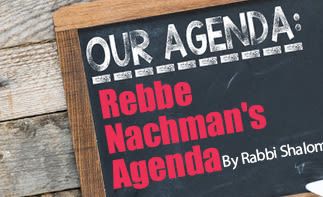
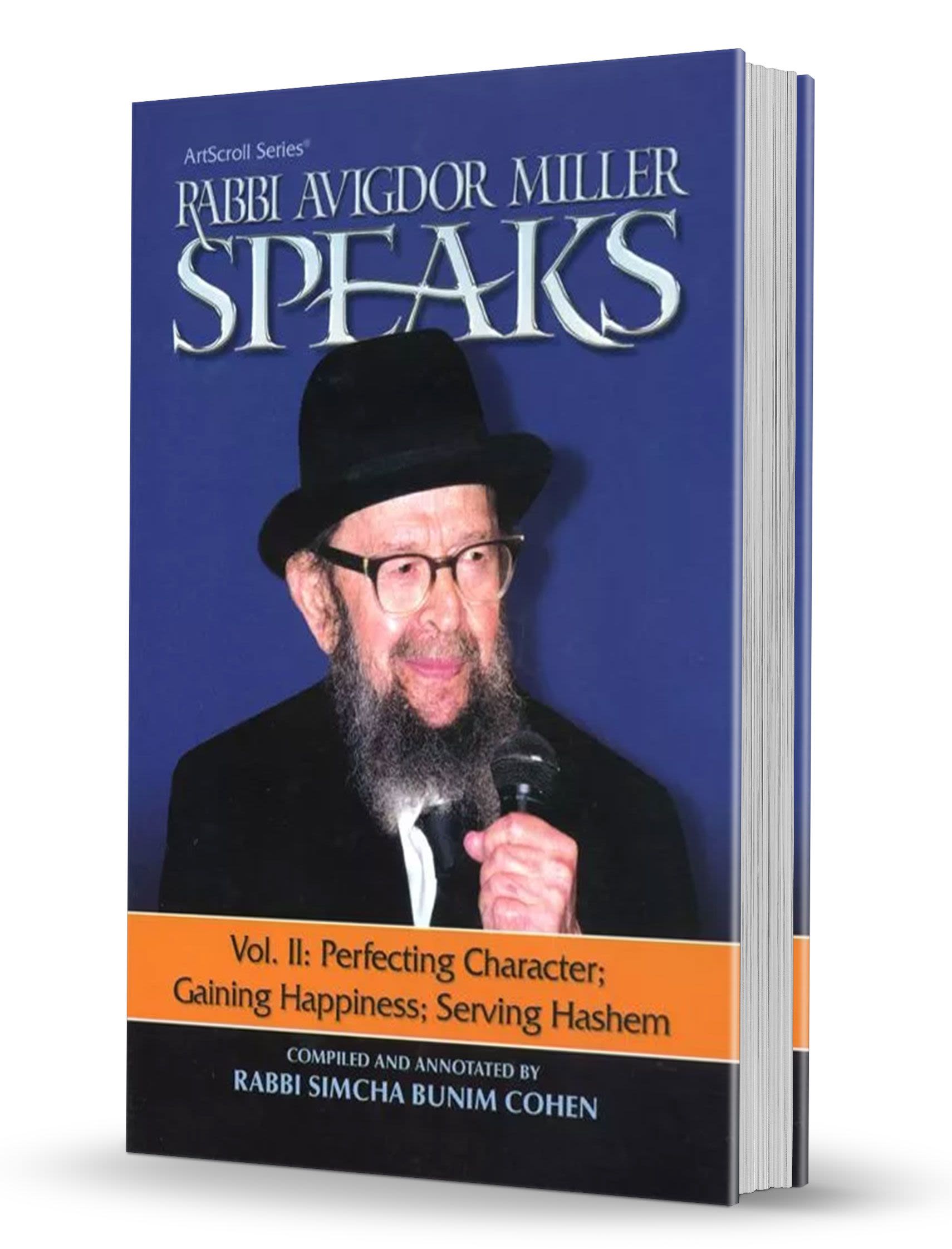
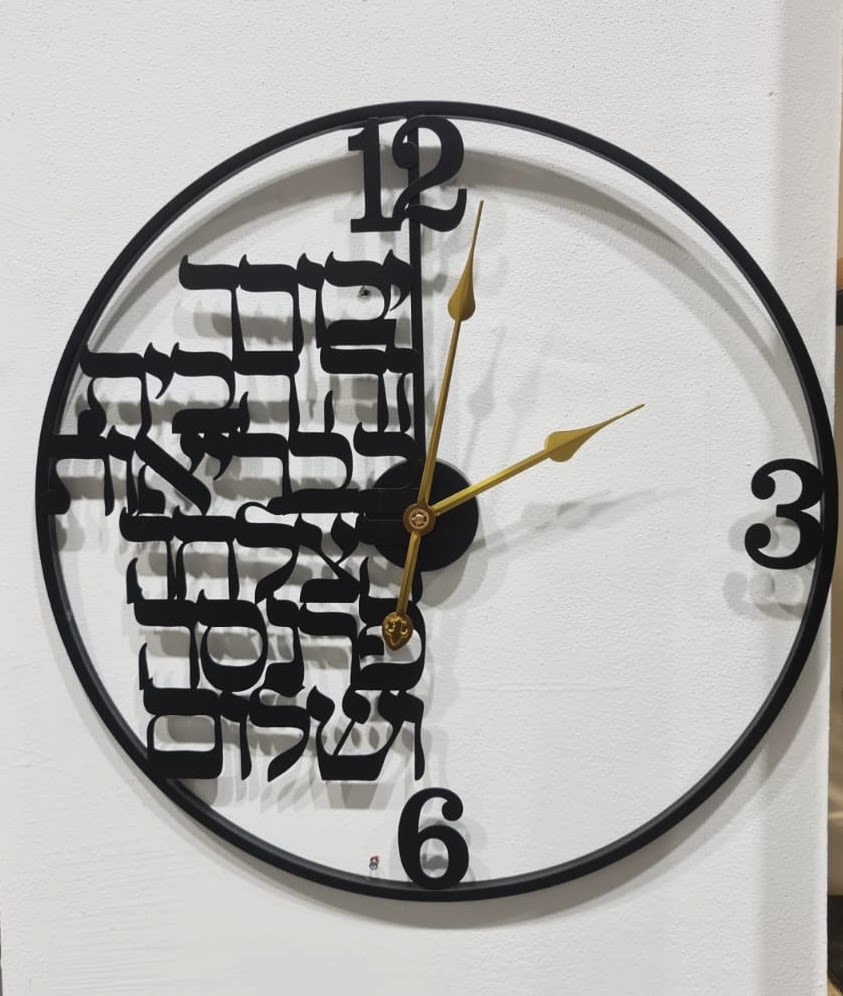
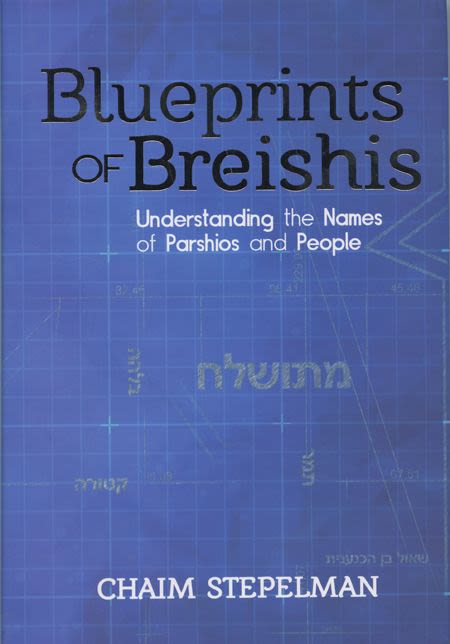

Tell us what you think!
Thank you for your comment!
It will be published after approval by the Editor.